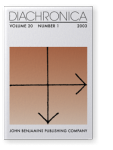Vol. 20:1 (2003) ► pp.83–137
Philological evidence for *e and *o in Pre-Old Japanese
Many Japanese historical linguists reconstruct a four-vowel system without *e and *o for Proto-Japonic (PJ), the ancestor of the Japanese and Ryukyuan languages. However, a few (Unger 1993 [1977], Hattori 1978–79, Thorpe 1983, Serafim 1999a, 1999b) have reconstructed PJ *e and *o. Until now, arguments for PJ *e and *o have been based on (a) Japonic internal and comparative reconstructions and (b) Japonic languages attested from the eighth century onward. In this paper I test the PJ *e and *o hypothesis using two other types of evidence: pre-eighth century transcriptions and Sino-Japanese readings borrowed prior to the eighth century.
Cited by
Cited by 4 other publications
This list is based on CrossRef data as of 1 july 2024. Please note that it may not be complete. Sources presented here have been supplied by the respective publishers. Any errors therein should be reported to them.
